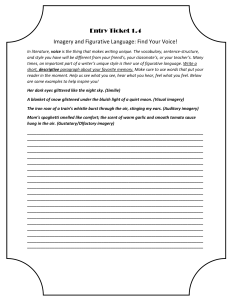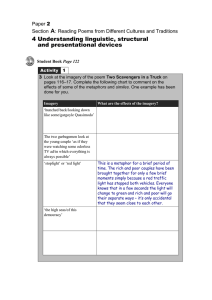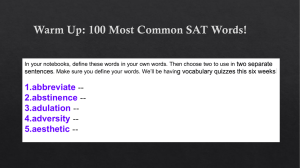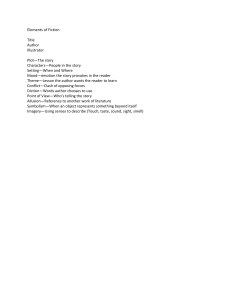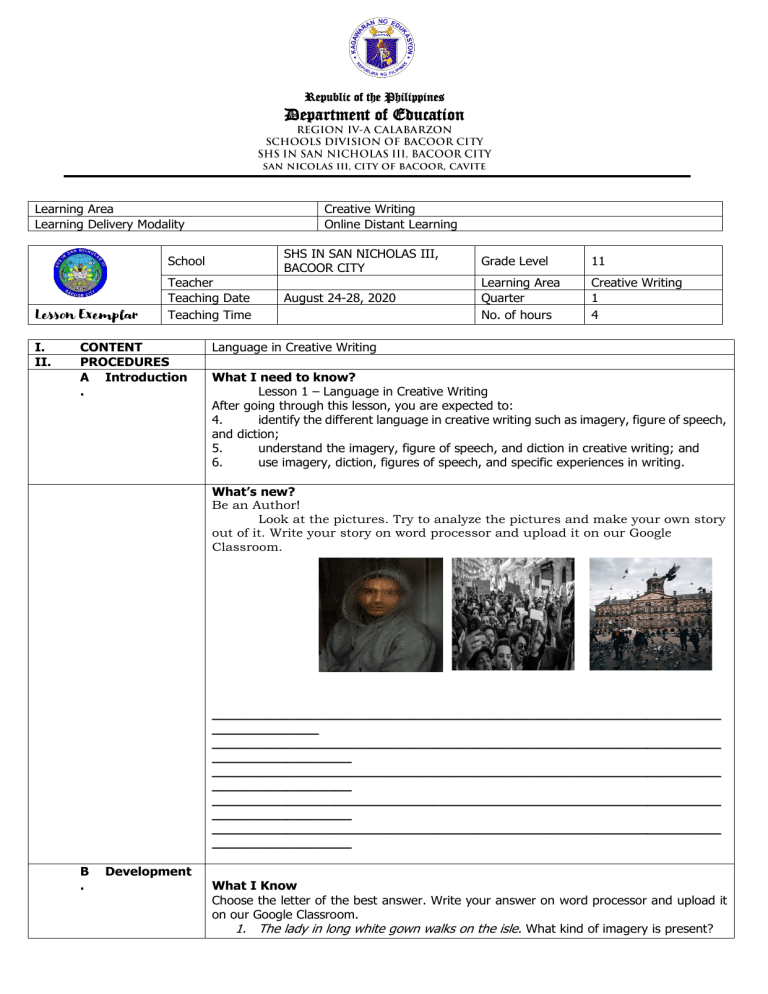
Republic of the Philippines Department of Education Learning Area Learning Delivery Modality Lesson Exemplar I. II. Creative Writing Online Distant Learning School SHS IN SAN NICHOLAS III, BACOOR CITY Grade Level 11 Teacher Teaching Date Teaching Time August 24-28, 2020 Learning Area Quarter No. of hours Creative Writing 1 4 CONTENT PROCEDURES A Introduction . Language in Creative Writing What I need to know? Lesson 1 – Language in Creative Writing After going through this lesson, you are expected to: 4. identify the different language in creative writing such as imagery, figure of speech, and diction; 5. understand the imagery, figure of speech, and diction in creative writing; and 6. use imagery, diction, figures of speech, and specific experiences in writing. What’s new? Be an Author! Look at the pictures. Try to analyze the pictures and make your own story out of it. Write your story on word processor and upload it on our Google Classroom. ______________________________________________________________ _____________ ______________________________________________________________ _________________ ______________________________________________________________ _________________ ______________________________________________________________ _________________ ______________________________________________________________ _________________ B . Development What I Know Choose the letter of the best answer. Write your answer on word processor and upload it on our Google Classroom. 1. The lady in long white gown walks on the isle. What kind of imagery is present? a. b. c. d. Visual Imagery Kinesthetic Imagery Gustatory Imagery Tactile Imagery 2. In the night sky, the waves are rushing to the shore. What kind of imagery is present? a. Kinesthetic Imagery b. Visual Imagery c. Gustatory Imagery d. Tactile Imagery 3. It is a short, commonplace saying that is universally understood in today’s language and used to express general truths. a. idioms b. proverbs c. smile d. metaphor 4. It is a very common figure of speech that uses the words “like” and “as” to compare two things that are not related by definition. a. idioms b. proverbs c. smile d. metaphor 5. This can be defined as a style of speaking or writing, determined by the choice of words by a speaker or a writer. a. pronunciation b. figure of speech c. diction d. language 6. Which a. b. c. d. of the following is not a type of imagery? visual imagery auditory imagery extrasensory imagery tactile imagery 7. How does imagery help us understand the story? a. It does not. b. By expressing how the author is feeling . c. Imagery helps us to see, touch, taste, smell, and feel what the characters feel and see. d. By telling the mood. 8. Treasure Island (an excerpt) by Robert Louis Stevenson I remember him as if it were yesterday, as he came plodding to the inn door, his sea-chest following behind him in a hand-barrow – a tall, strong, heavy, nutbrown man, his tarry pigtail falling over the shoulder of his soiled blue coat, his hands ragged and scarred, with black, broken nails, and the sabre cut across one cheek, a dirty, livid white. I remember him looking round the cover and whistling to himself as he did so, and then breaking out in that old sea-song that he sang so often afterwards. What does the IMAGERY used in the first paragraph tell the reader about the captain? a. He is in need of first aid. b. He is likely carrying treasure in his sea-chest. c. He has grown frail and tired with old age. d. He has had a rough and adventurous life. 9. What does this idiom mean? (break a leg) a. chicken is my life (by Jayme) b. I don't like you! c. To literally break a leg d. good luck! 10. You are a good person, but your political ideas are half-baked. What is the meaning of 'half-baked'? a. Boring b. Carefully considered c. Very relevant d. Not well considered 11. After going to the zoo, the mall, and the movies, Cassie was sick of bending over backwards to entertain her nieces. a. Cassie was doing very little to entertain her nieces. b. Cassie was making small efforts to entertain her nieces. c. Cassie was trying very hard to entertain her nieces. d. Cassie was not trying at all to entertain her nieces. 12. Which a. b. c. d. of the following is written in a formal diction? “The adventurers rode thru the forest with their swords drawn.” “We shouldn’t have to do this kind of junk, anyway!” “Steve and Adam will be out of town this weekend.” “I would be very pleased to snag a job at WLC’s development office.” 13. Why should you use caution in imitating the diction of professional scholars? a. Because academic diction should only be used by professionals b. Because this could count as plagiarism c. Because many professional scholars are poor writers d. All of the above 14. Which a. b. c. of the following statements is NOT true? Words affect the reader. An author's diction has little to no effect on the reader. The word that you choose is important because it might affect the reader in a different way than another word. d. None of the statements are true 15. When considering diction, which of the following BEST describes 'the right word?' a. The one that is the most difficult to pronounce b. The one that best expresses the author's intent c. The one found in a thesaurus d. The one that everyone understands What’s in? In the previous lesson, you have learned about the Sensory Experiences as part of creative writing. Before you learn something new, try to do the following activity. Direction: Answer the following by writing TRUE if the statement is correct and FALSE of not. _______________1. Sensory details include sight, sound, touch, smell, and taste. Writers employ the five senses to engage a reader's interest. _______________2. Olfactory is associated with the sense of smell. _______________3. Visual is associated witht the sense of taste. _______________4. Gustatory is associate with the sense of sight. _______________5. Kinestetic is associated with the sense of touch. What is it? IMAGERY Imagery is a language used by poets, novelists, and other writers to create images in the mind of the reader. Imagery includes figurative and metaphorical language to improve the reader's experience through their senses. • Visual imagery engages the sense of sight. This is what you can see, and includes visual descriptions. Physical attributes including color, size, shape, lightness and darkness, shadows, and shade are all part of visual imagery. Example Imagery using visuals: The night was black as ever, but bright stars lit up the sky in beautiful and varied constellations that were sprinkled across the astronomical landscape. In this example, the experience of the night sky is described in-depth with color (black as ever, bright), shape (varied constellations), and pattern(sprinkled). • Gustatory imagery engages the sense of taste. This is what you can taste, and includes flavors. This can include the five basic tastes—sweet, salty, bitter, sour, and umami—as well as the textures and sensations tied to the act of eating. Example Imagery using taste: The candy melted in her mouth and swirls of bittersweet chocolate and slightly sweet but salty caramel blended on her tongue. Thanks to an in-depth description of the candy’s various flavors, the reader can almost experience the deliciousness directly. • Tactile imagery engages the sense of touch. This is what you can feel, and includes textures and the many sensations a human being experiences when touching something. Differences in temperature is also a part of tactile imagery. Example Imagery using touch: After the long run, he collapsed in the grass with tired and burning muscles. The grass tickled his skin and sweat cooled on his brow. In this example, imagery is used to describe the feeling of strained muscles, grass's tickle, and sweat cooling on the skin. • Auditory imagery engages the sense of hearing. This is the way things sound. Literary devices such as onomatopoeia and alliteration can help create sounds in writing. Example Imagery using sounds: The silence was broken by the peal of piano keys as Shannon began practicing her concerto. Here, auditory imagery breaks silence with the beautiful sound of piano keys. • Olfactory imagery engages the sense of smell. The scent is one of the most direct triggers of memory and emotion but can be difficult to write about. Since taste and smell are so closely linked, you'll sometimes find the same words (such as "sweet") used to describe both. The simile is common in olfactory imagery because it allows writers to compare a particular scent to common smells like dirt, grass, manure, or roses. Example Imagery using scent She smelled the scent of sweet hibiscus wafting through the air, its tropical smell a reminder that she was on vacation in a beautiful place. The scent of hibiscus helps describe a scene that is relaxing, warm, and welcoming. • Kinesthetic imagery (a.k.a kinesthesia) engages the feeling of movement. This can be similar to tactile imagery but deals more with full-body sensations, such as those experienced during exercise. Rushing water, flapping wings, and pounding hearts are all examples of kinesthetic imagery. Example Sense of movement: The rushing water relaxes me whenever I got home to the province. The rushing water helps describe the movement of the water which is relaxing. FIGURES OF SPEECH A figure of speech is a word or phrase using figurative language—language that has other meanings than its normal definition. In other words, figures of speech rely on implied or suggested meaning, rather than a dictionary definition. We express and develop them through hundreds of different rhetorical techniques, from specific types like metaphors and similes to more general forms like sarcasm and slang. Types of Figure of Speech • Metaphor Many common figures of speech are metaphors. That is, they use words in a manner other than their literal meaning. However, metaphors use figurative language to make comparisons between unrelated things or ideas. The "peak of her career," for example, is a metaphor, since career is not a literal mountain with a peak, but the metaphor represents the idea of arriving at the highest point of one's career. • Idiom An idiom is a common phrase with a figurative meaning. Idioms are different from other figures of speech in that their figurative meanings are mostly known within a particular language, culture, or group of people. The English language alone has about 25,000 idioms. Some examples include "it's raining cats and dogs" when it is raining hard, or "break a leg" when wishing someone good luck. Example This sentence uses an idiom to make it more interesting: There are a supermarket and a pharmacy in the mall, so if we go there, we can kill two birds with one stone. The idiom is a common way of saying that two tasks can be completed in the same amount of time or the same place. • Proverb A proverb is a short, commonplace saying that is universally understood in today's language and used to express general truths. "Don't cry over spilled milk" is a popular example. Most proverbs employ metaphors (e.g. the proverb about milk isn't literally about milk). Example This example uses a proverb to emphasize the situation: I know you think you’re going to sell all of those cookies, but don’t count your chickens before they hatch! Here, "don't count your chickens before they hatch" means that you shouldn't act like something has happened before it does. • Simile A simile is a very common figure of speech that uses the words "like" and "as" to compare two things that are not related by definition. For example, "he is as tall as a mountain," doesn't mean he was 1,000 feet tall, it just means he was tall. Example This example uses a simile for comparison: The internet is like a window to the world—you can learn about everything online! The common phrase “window to the world” refers to a hypothetical window that lets you see the whole world from it. So, saying the internet is like a window to the world implies that it lets you see anything and everything. • Irony The irony is when a word or phrase's literal meaning is the opposite of its figurative meaning. Many times (but not always), the irony is expressed with sarcasm, For example, maybe you eat a really bad cookie, and then say "Wow, that was the best cookie I ever had"—of course, what you mean is that it's the worst cookie you ever had, but being ironic emphasizes just how bad it was! DICTION Diction can be defined as a style of speaking or writing, determined by the choice of words by a speaker or a writer. Diction, or choice of words, often separates good writing from bad writing. It depends on several factors. Firstly, the word has to be right and accurate. Secondly, words should be appropriate to the context in which they are used. Lastly, the choice of words should be such that the listener or reader understands easily. Types of Diction Individuals vary their diction depending on different contexts and settings. Therefore, we come across various types of diction. • Formal diction – formal words are used in formal situations, such as press conferences and presentations. Example: Ode on a Grecian Urn (By John Keats) John Keats, in his Ode on a Grecian Urn, uses formal diction to achieve a certain effect. He says: “Heard melodies are sweet, but those unheard Are sweeter: therefore, ye soft pipes, play on …” Notice the use of the formal “ye,” instead of the informal “you.” The formality here is due to the respect the urn inspires in Keats. In the same poem he says: “Ah, happy, happy boughs! that cannot shed Your leaves, nor ever bid the spring adieu.” It is more formal to use “adieu” than to say “goodbye.” • Informal diction – uses informal words and conversation, such as writing or talking to friends. Example: The Sun Rising (By John Donne) In sharp contrast to Keats, John Donne uses colloquialism in his poem The Sun Rising: “Busy old fool, unruly Sun, Why dost thou thus, Through windows, and curtains, call on us? Must to thy motions lovers’ seasons run? Saucy pedantic wretch, go chide. “ Treating the sun like a real human being in this excerpt, the poet informally speaks to the sun, using colloquial expressions. He rebukes the sun because it has appeared to spoil the good time he is having with his beloved. Further, he orders the "saucy pedantic sun" to go away. • Colloquial diction – uses words common in everyday speech, which may be different in different regions or communities. Example: The School (By Donald Barthelme) Writers skillfully choose words to develop a certain tone and atmosphere in their works. Read the following excerpt from a short story The School, by Donald Barthelme: "And the trees all died. They were orange trees. I don't know why they died, they just died. Something wrong with the soil possibly or maybe the stuff we got from the nursery wasn't the best. We complained about it. So we've got thirty kids there, each kid had his or her little tree to plant and we've got these thirty dead trees. All these kids looking at these little brown sticks, it was depressing." The use of the words “died,” “dead,” “brown sticks,” and “depressing” gives a gloomy tone to the passage. • Slang diction – is the use of words that are newly coined, or even impolite. Example: A Tale of Two Cities (By Charles Dickens) Sometimes writers repeat their chosen words or phrases to achieve an artistic effect, such as in the following example from A Tale of Two Cities, by Charles Dickens: “It was the best of times, it was the worst of times, it was the age of wisdom, it was the age of foolishness, it was the epoch of belief, it was the epoch of incredulity, it was the season of Light, it was the season of Darkness, it was the spring of hope, it was the winter of despair.” C . Engagement By repeating the phrase “It was the …” throughout the passage, the writer ensures that the readers will give more consideration to the characteristic of the era they are going to read about in the novel. What’s more? Identify what language is present on each statement. Choose from the box. Write your answer on a separate sheet on word processor and upload in our google classroom. visual imagery gustatory imagery kinesthetic imagery tactile imagery olfactory imager auditory imagery metaphor idiom proverbs simile irony formal informal colloquial slang ____________1. A traffic cop gets suspended for not paying his parking tickets. ____________2. She's a night owl walking on the steet every night. ____________3. Forgiveness is like fragrance from crashing flower. ____________4. I could hear the popping and crackling as mom dropped the bacon into the frying pan, and soon the salty, greasy smell wafted toward me. ____________5. Glittering white, the blanket of snow covered everything in sight. ____________6. The beginning of knowledge is wisdom. ____________7. The salty water of the sea makes me calm. ____________8. “Heard melodies are sweet, but those unheard Are sweeter: therefore, ye soft pipes, play on …” ______________9. Hey, kid. Nice to meet ya. What's up? ______________10. Please meet my frenemy Carla. What I can do? BE THE AUTHOR!! Direction: Create your poem and creative story using the pictures provided. Use Imagery, Figure of Speech, and Diction. Underline word/s that indicates the language used in your poem and essay. Write your story or poem on word processor and upload it on our Google Classroom. Make your poem using these pictures D . Assimilation Make your creative essay using these pictures What I have learned? Complete the paragraph base on what have you learned. Rewrite the paragraph using word processor and upload on our Google Classroom ______________________ is the language used by poets, novelists, and other writers to create images in the mind of the reader. Imagery includes figurative and metaphorical language to improve the reader's experience through their senses. The six (6) basic imagery senses involve ___________________ ______________, _____________________, ________________________, ______________________, and _____________________. A ________________________________ is a word or phrase using figurative language—language that has other meanings than its normal definition. In other words, figures of speech rely on implied or suggested meaning, rather than a dictionary definition. Some of the widely used figures of speech are __________________, _________________, __________________, _______________, and _____________ ________________________ can be defined as a style of speaking or writing, determined by the choice of words by a speaker or a writer. Diction, or choice of words, often separates good writing from bad writing. Diction could be _______________, ________________, _________________, or _______________. What I can do? (Assessment) Choose the letter of the best answer. Write your answer on word processor and upload it on our Google Classroom. 1. It is a very common figure of speech that uses the words “like” and “as” to compare two things that are not related by definition. a. idioms b. proverbs 2. 3. 4. 5. 6. 7. 8. 9. c. smile d. metaphor This can be defined as a style of speaking or writing, determined by the choice of words by a speaker or a writer. a. pronunciation b. figure of speech c. diction d. language It is a short, commonplace saying that is universally understood in today’s language and used to express general truths. a. idioms b. proverbs c. smile d. metaphor The lady in long white gown walks on the isle. What kind of imagery is present? a. Visual Imagery b. Kinesthetic Imagery c. Gustatory Imagery d. Tactile Imagery In the night sky, the waves are rushing to the shore. What kind of imagery is present? a. Kinesthetic Imagery b. Visual Imagery c. Gustatory Imagery d. Tactile Imagery Which of the following is not a type of imagery? a. visual imagery b. auditory imagery c. extrasensory imagery d. tactile imagery How does imagery help us understand the story? a. It does not b. By expressing how the author is feeling c. Imagery helps us to see, touch, taste, smell, and feel what the characters feel and see d. By telling the mood Treasure Island (an excerpt) by Robert Louis Stevenson I remember him as if it were yesterday, as he came plodding to the inn door, his sea-chest following behind him in a hand-barrow – a tall, strong, heavy, nutbrown man, his tarry pigtail falling over the shoulder of his soiled blue coat, his hands ragged and scarred, with black, broken nails, and the sabre cut across one cheek, a dirty, livid white. I remember him looking round the cover and whistling to himself as he did so, and then breaking out in that old sea-song that he sang so often afterwards. What does the IMAGERY used in the first paragraph tell the reader about the captain? a. He is in need of first aid. b. He is likely carrying treasure in his sea-chest. c. He has grown frail and tired with old age. d. He has had a rough and adventurous life. What does this idiom mean? (break a leg) a. chicken is my life (by Jayme) b. I don't like you! c. To literally break a leg d. good luck! 10. You are a good person, but your political ideas are half-baked. What is the meaning of 'half-baked'? a. Boring b. Carefully considered c. Very relevant d. Not well considered 11. After going to the zoo, the mall, and the movies, Cassie was sick of bending over backwards to entertain her nieces. a. Cassie was doing very little to entertain her nieces. b. Cassie was making small efforts to entertain her nieces. c. Cassie was trying very hard to entertain her nieces. d. Cassie was not trying at all to entertain her nieces. 12. Which of the following is written in a formal diction? a. “The adventurers rode thru the forest with their swords drawn.” b. “We shouldn’t have to do this kind of junk, anyway!” c. “Steve and Adam will be out of town this weekend.” d. “I would be very pleased to snag a job at WLC’s development office.” 13. Why should you use caution in imitating the diction of professional scholars? a. Because academic diction should only be used by professionals b. Because this could count as plagiarism c. Because many professional scholars are poor writers d. All of the above 14. Which of the following statements is NOT true? a. Words affect the reader. b. An author's diction has little to no effect on the reader. c. The word that you choose is important because it might affect the reader in a different way than another word. d. None of the statements are true 15. When considering diction, which of the following BEST describes 'the right word?' a. The one that is the most difficult to pronounce b. The one that best expresses the author's intent c. The one found in a thesaurus d. The one that everyone understands III. REFLECTION I UNDERSTAND THAT Write your reflection on word processor and upload it on our Google Classroom. Three concepts I learned: 1. ________________________________________ 2. ________________________________________ 3. ________________________________________ I REALIZED THAT Two real-life realizations after finishing the topic 1. ________________________________________ 2. ________________________________________ One most favorite part of the lesson 1. ________________________________________ 2. ________________________________________ What I Know 1. A 2. A 3. B 4. C 5. C 6. C 7. C 8. C 9. D 10.D 11.C 12.D 13.B 14.B 15.D What's More 1. irony 2. metaphor 3. simile 4. Tactile Imagery 5. Visual Imagery 6. proverbs 7. Gustatory Imagery 8. formal 9. informal 10.slang Assessment 1. C 2. C 3. B 4. A 5. A 6. C 7. C 8. C 9. D 10.D 11.C 12.D 13.B 14.B 15.D ANSWER KEY
